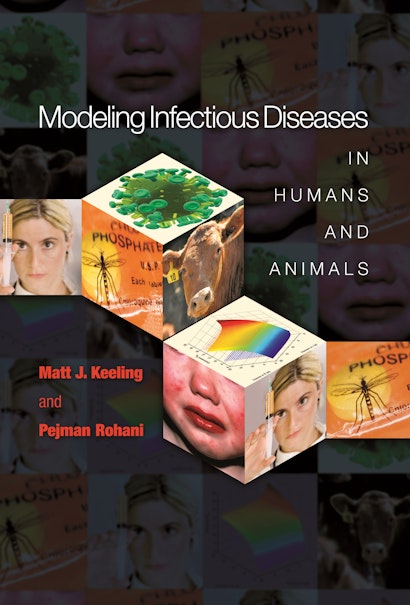For epidemiologists, evolutionary biologists, and health-care professionals, real-time and predictive modeling of infectious disease is of growing importance. This book provides a timely and comprehensive introduction to the modeling of infectious diseases in humans and animals, focusing on recent developments as well as more traditional approaches.
Matt Keeling and Pejman Rohani move from modeling with simple differential equations to more recent, complex models, where spatial structure, seasonal “forcing,” or stochasticity influence the dynamics, and where computer simulation needs to be used to generate theory. In each of the eight chapters, they deal with a specific modeling approach or set of techniques designed to capture a particular biological factor. They illustrate the methodology used with examples from recent research literature on human and infectious disease modeling, showing how such techniques can be used in practice. Diseases considered include BSE, foot-and-mouth, HIV, measles, rubella, smallpox, and West Nile virus, among others. Particular attention is given throughout the book to the development of practical models, useful both as predictive tools and as a means to understand fundamental epidemiological processes. To emphasize this approach, the last chapter is dedicated to modeling and understanding the control of diseases through vaccination, quarantine, or culling.
- Comprehensive, practical introduction to infectious disease modeling
- Builds from simple to complex predictive models
- Models and methodology fully supported by examples drawn from research literature
- Practical models aid students’ understanding of fundamental epidemiological processes
- For many of the models presented, the authors provide accompanying programs written in Java, C, Fortran, and MATLAB
- In-depth treatment of role of modeling in understanding disease control
Matt J. Keeling is professor in the Department of Biological Sciences and the Mathematics Institute at the University of Warwick. Pejman Rohani is associate professor in the Institute of Ecology and the Center for Tropical and Emerging Global Diseases at the University of Georgia.
"Matt Keeling and Pejman Rohani...have made important and original contributions to epidemiology...and are well qualified to deliver an authoritative, comprehensive and up-to-date review. [The authors] advocate...the use of mathematical models to help design disease-control programs. They recognize that modeling is a partnership between modelers and empiricists. For that reason, I hope that [readership] will extend beyond existing and new devotees of this challenging and exciting discipline."—Mark Woolhouse, Nature
"This book represents a valuable step toward educating readers to have greater appreciation and understanding of the development of mathematical models in infectious diseases."—Carol Y. Lin, Biometrics Book Reviews
"[T]he authors have created a well written and essential reference for epidemiologists, mathematicians and other scientists interested in the mathematical modeling of infectious diseases."—Michael Hohle, Biometrical Journal
"Mathematical models of infectious disease have proven to be a valuable component of public health planning and response, as well as an important application of population biology. Keeling and Rohani have written an accessible and much-needed introduction to this field that will be suitable for graduate students and advanced undergraduates alike."—Carl T. Bergstrom, University of Washington
"Mathematical models are now as crucial in the study of infectious diseases as are microscopes, stethoscopes, and the tools of molecular diagnosis. These models have contributed to epidemiological understanding at all levels, from projections of the magnitude of the AIDS epidemic to an understanding of the within-host interactions between pathogens and the host's immune system. This book outlines all the major developments in mathematical epidemiology that have occurred since the publication of Anderson and May's classic synthesis in Infectious Diseases of Humans. It is highly recommended to all students of infectious disease biology who require a detailed and well-organized introduction to the mathematical models needed to understand the dynamics of infectious diseases."—Andrew Dobson, Princeton University

